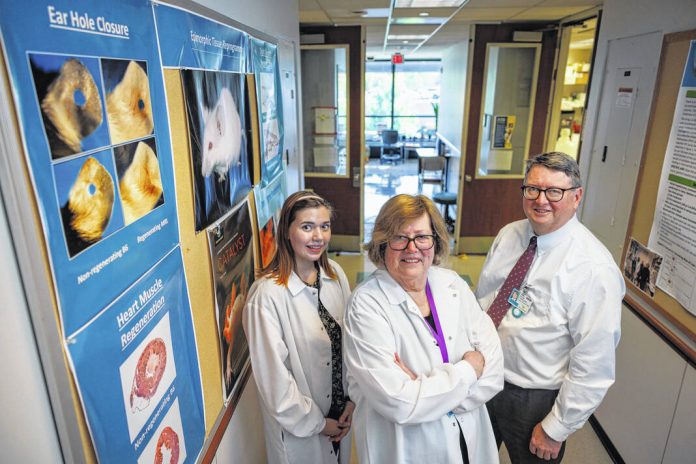
At Lankenau Institute for Medical Research, Ellen Heber-Katz (center) has discovered how to regenerate damaged nerves and other wounds in lab animals without scarring, such as the holes in the mouse ears in the poster at left. Also shown, research assistant Alexis Mengel and institute chief executive officer George Prendergast.
Alejandro A. Alvarez/The Philadelphia Inquirer/TNS
Ellen Heber-Katz thought the experiment was ruined.
Her post-doctoral researcher was supposed to have punched tiny holes in the ears of laboratory mice at Philadelphia’s Wistar Institute, using a standard technique to indicate which ones had received an experimental treatment. But when Heber-Katz checked the animals a few weeks later, all their ears were intact.
The post-doc nevertheless insisted that she had punched the ear holes, so the scientists tried it again with different mice. Three weeks later, the holes in those mouse ears vanished, too. Not only had the wounds healed, but the ears looked completely normal, with new cartilage, hair and no trace of scarring.
Heber-Katz had stumbled on a type of super-healing mice, launching her on a quest that has lasted more than two decades. First, she deciphered the genetic quirks that gave the animals this restorative ability. (The super-healing was an unintended consequence of their laboratory-bred autoimmune disease.) Then she and colleagues figured out how to activate this response in normal mice by simply injecting them with a drug.
Now at Lankenau Institute for Medical Research, Heber-Katz has demonstrated the drug’s promise against a variety of conditions in mice and rats — not only external wounds, but also nerve damage, periodontal disease, and osteoporosis. What’s happening is more than healing, she says, likening her results to salamanders’ ability to regenerate missing limbs.
A note of caution: Most drugs that work in mice do not end up being effective in humans. In this case, some biologists caution that true regeneration is a complex process that’s almost unheard of in mammals, and they are skeptical that it can be activated by simply administering a drug.
Undaunted, Heber-Katz says the drug prompts the growth of healthy new cells almost like what happens in a mouse (or human) embryo. When it is administered to gray-haired, 3-year-old mice (roughly equivalent to 90-year-old humans), the animals’ wounds recover in a way that seems to turn back time.
“The hair grows back completely,” she said. “It even goes from gray to black.”
The health problems Heber-Katz is tackling are immense. The United States spends billions every year on wound care alone, including the treatment of diabetic skin ulcers and other chronic, nonhealing wounds.
Her success in treating nerve damage, meanwhile, has drawn funding from the military, in addition to her recurring grants from the National Institutes of Health and private donors.
A Northeast Philly native, Heber-Katz is determined to translate her laboratory successes to the real world. She and Phillip B. Messersmith, a professor of bioengineering at the University of California, Berkeley, have patented the use of the drug, called 1,4-DPCA, for use in tissue regeneration. The pair also have founded a company called MRL Bio, named after the breed of autoimmune mice with the enhanced healing ability.






